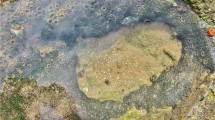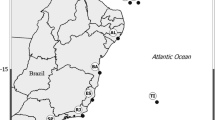Abstract
Zooxanthellate zoanthid colonies of the species Zoanthus sansibaricus (Cnidaria: Anthozoa: Hexacorallia) are present both in the intertidal zone and at depths greater than 7 m at three locations (Manza, Zanpa, Sunabe) along the west coast of Okinawa, Japan. In this study, the identity of Z. sansibaricus colonies from various depths as the same species was confirmed using morphological analyses of tentacle numbers, polyp diameter, and nematocyst examination. In addition, molecular analyses of sequences of mitochondrial cytochrome oxidase subunit I and the internal transcribed spacer region 2 of ribosomal DNA (ITS2-rDNA) were performed. Surveys from 0 to 35 m depths at Manza indicated that the populations of Z. sansibaricus were discontinuous in their bathymetrical distribution, with few or no Z. sansibaricus colonies found at depths of 4–7 m. Examination of Symbiodinium (=zooxanthellae) types within Z. sansibaricus colonies by phylogenetic analyses of Symbiodinium ITS2-rDNA showed clear differences between the two populations, with some (=27 %) intertidal colonies having Symbiodinium clade A, while all deeper subtidal (>7 m depth) colonies possessed Symbiodinium clade C (n = 18). Detailed phylogenetic analyses further indicated significant differences within Symbiodinium clade C populations over depth. From this study, it is clear that the zoanthid Z. sansibaricus has some variation in its symbiosis with Symbiodinium, potentially allowing the species to colonize different depths in the subtropical coral reef environment of Okinawa, and that its range extends far past the shallow subtidal zone as previously believed.




Similar content being viewed by others
References
Acuña FH, Garese A (2008) The cnidae of the acrospheres of the corallimorpharian Corynactis carnea (Studer, 1878) (Cnidaria, Corallimorpharia, Corallimorphidae): composition, abundance and biometry. Belg J Zool 138:50–57
Banaszak AT, LaJeunesse TC, Trench RK (2000) The synthesis of mycosporine-like amino acids (MAAs) by cultured symbiotic dinoflagellates. J Exp Mar Biol Ecol 249:219–233
Bo M, Lavorato A, Di Camillo CG, Poliseno A, Baquero A, Bavestrello G, Irei Y, Reimer JD (2012) Black coral assemblages from Machalilla National Park (Ecuador). Pac Sci 66:63–82
Burnett WJ (2002) Longitudinal variation in algal symbionts (zooxanthellae) from the Indian Ocean zoanthid Palythoa caesia. Mar Ecol Prog Ser 234:105–109
Carlos AA, Baillie BK, Kawachi M, Maruyama T (1999) Phylogenetic position of Symbiodinium (Dinophyceae) isolates from tridacnids (Bivalvia), cardiids (Bivalvia), a sponge (Porifera), a soft coral (Anthozoa), and a free-living strain. J Phycol 35:1054–1062
Excoffier L, Smouse P, Quattro J (1992) Analysis of molecular variance inferred from metric distances among DNA haplotypes: application to human mitochondrial DNA restriction data. Genetics 131:479–491
Excoffier L, Laval G, Schneider S (2005) Arlequin ver. 3.0: An integrated software package for population genetics data analysis. Evol Bioinformatics Online 1:47–50
Folmer O, Black M, Hoeh W, Lutz R, Vrijenhoek R (1994) DNA primers for amplification of mitochondrial cytochrome c oxidase subunit I from diverse metazoan invertebrates. Mol Mar Biol Biotechnol 3:294–299
Frade PR, De Jongh F, Vermeulen F, Van Bleijswijk J, Bak RPM (2008a) Variation of symbiont distribution between closely related coral species over large depth ranges. Mol Ecol 17:691–703
Frade PR, Englebert N, Faria J, Visser PM, Bak RPM (2008b) Distribution and photobiology of Symbiodinium types in different light environments for three colour morphs of the coral Madracis pharensis: is there more to it that total irradiance? Coral Reefs 27:913–925
Guindon S, Gascuel O (2003) A simple, fast, and accurate algorithm to estimate large phylogenies by maximum likelihood. Syst Biol 52:696–704
Hoegh-Guldberg O (1999) Climate change, coral bleaching and the future of the world’s coral reefs. Mar Freshw Res 50:839–866
Irei Y, Nozawa Y, Reimer JD (2011) Distribution patterns of five zoanthid species in Okinawa Island, Japan. Zool Stud 50:426–433
Kimura M (1980) A simple method for estimating evolutionary rates of base substitutions through comparative studies of nucleotide sequences. J Mol Evol 16:111–120
LaJeunesse TC (2002) Diversity and community structure of symbiotic dinoflagellates from Caribbean coral reefs. Mar Biol 141:387–400
LaJeunesse TC (2005) “Species” radiations of symbiotic dinoflagellates in the Atlantic and Indo-Pacifc since the Miocene–Pliocene transition. Mol Biol Evol 22:570–581
LaJeunesse TC, Trench RK (2000) Biogeography of two species of Symbiodinium (Freudenthal) inhabiting the intertidal sea anemone Anthopleura elegantissima (Brandt). Biol Bull 199:126–134
Mieog JC, van Oppen MJH, Cantin NE, Stam WT, Olsen JL (2007) Real-time PCR reveals a high incidence of Symbiodinium clade D at low levels in four scleractinian corals across the Great Barrier Reef: implications for symbiont shuffling. Coral Reefs 26:449–457
Ono S, Reimer JD, Tsukahara J (2005) Reproduction of Zoanthus sansibaricus in the infra-littoral zone at Taisho Lava Field, Sakurajima, Kagoshima, Japan. Zool Sci 22:247–255
Pochon X, Gates RD (2010) A new Symbiodinium clade (Dinophyceae) from soritid foraminifera in Hawai’i. Mol Phylogenet Evol 56:492–497
Reimer JD (2008) Implications for different diversity levels of Symbiodinium spp. (Dinophyceae, Suessiales) within closely related hosts: zoanthids (Cnidaria: Hexacorallia: Anthozoa) as a case study. Galaxea 10:3–13
Reimer JD, Fujii T (2010) Four new species and one new genus of zoanthids (Cnidaria: Hexacorallia) from the Galápagos. ZooKeys 42:1–36
Reimer JD, Ono S, Takishita K, Fujiwara Y, Tsukahara J (2004) Reconsidering Zoanthus spp. diversity: molecular evidence of conspecifity within four previously presumed species. Zool Sci 21:517–525
Reimer JD, Ono S, Iwama A, Tsukahara J, Takishita K, Maruyama T (2006a) Morphological and molecular revision of Zoanthus (Anthozoa: Hexacorallia) from southwestern Japan with description of two new species. Zool Sci 23:261–275
Reimer JD, Takishita K, Maruyama T (2006b) Molecular identification of symbiotic dinoflagellates (Symbiodinium spp.) from Palythoa spp. (Anthozoa: Hexacorallia) in Japan. Coral Reefs 25:521–527
Reimer JD, Takishita K, Ono S, Maruyama T, Tsukahara J (2006c) Latitudinal and intracolony ITS-rDNA sequence variation in the symbiotic dinoflagellate genus Symbiodinium (Dinophyceae) in Zoanthus sansibaricus (Anthozoa: Hexacorallia). Phycol Res 54:122–132
Reimer JD, Hirano S, Fujiwara Y, Sinniger F, Maruyama T (2007a) Morphological and molecular characterization of Abyssoanthus nankaiensis, a new family, new genus and new species of deep-sea zoanthid (Anthozoa: Hexacorallia: Zoantharia) from a northwest Pacific methane cold seep. Invert Syst 21:255–262
Reimer JD, Ono S, Tsukahara J, Takishita K, Maruyama T (2007b) Non-seasonal clade-specificity and subclade microvariation in symbiotic dinoflagellates (Symbiodinium spp.) in Zoanthus sansibaricus (Anthozoa: Hexacorallia) at Kagoshima Bay, Japan. Phycol Res 55:58–65
Reimer JD, Takishita K, Ono S, Tsukahara J, Maruyama T (2007c) Molecular evidence suggesting intraspecific hybridization in Zoanthus (Anthozoa: Hexacorallia). Zool Sci 24:346–359
Reimer JD, Hirose M, Yanagi K, Sinniger F (2011) Marine invertebrate diversity in the oceanic Ogasawara Islands: a molecular examination of zoanthids (Anthozoa: Hexacorallia) and their Symbiodinium (Dinophycaea). Syst Biodivers 9:133–144
Reynolds J, Weir BS, Cockerham CC (1983) Estimation for the coancestry coefficient: basis for a short-term genetic distance. Genetics 105:767–779
Rowan R, Knowlton N (1995) Intraspecific diversity and ecological zonation in coral-algal symbiosis. Proc Natl Acad Sci USA 92:2850–2853
Ryland JS, Lancaster JE (2003) Revision of methods for separating species of Protopalythoa (Hexacorallia: Zoanthidea) in the tropical West Pacific. Invert Syst 17:407–428
Ryland JS, de Putron S, Scheltema RS, Chimonides PJ, Zhadan DG (2000) Semper’s (zoanthid) larvae: pelagic life, parentage and other problems. Hydrobiologia 440:191–198
Sinniger F, Häussermann V (2009) Zoanthids (Cnidaria: Hexacorallia: Zoantharia) from shallow water of the southern Chilean fjord region, with descriptions of a new genus and two new species. Org Divers Evol 9:23–36
Sinniger F, Reimer JD, Pawlowski J (2008) Potential of DNA sequences to identify zoanthids (Cnidaria: Zoantharia). Zool Sci 25:1253–1260
Sinniger F, Reimer JD, Pawlowski J (2010) The Parazoanthidae DNA taxonomy: description of two new genera. Mar Biodivers 40:57–70
Smith RT, Pinzon JH, LaJeunesse TC (2009) Symbiodinium (Dinophyta) diversity and stability in aquarium corals. J Phycol 45:1030–1036
Tchernov D, Gorbunov MY, de Vargas C, Yadav SN, Milligan AJ, Haggblom M, Falkowski PG (2004) Membrane lipids of symbiotic algae are diagnostic of sensitivity to thermal bleaching in corals. Proc Natl Acad Sci USA 101:13531–13535
Toller WW, Rowan R, Knowlton N (2001) Repopulation of zooxanthellae in the Caribbean corals Montastrea annularis and M. faveolata following experimental and disease-associated bleaching. Biol Bull 201:360–373
Acknowledgements
MISE laboratory members (2008–2011) are acknowledged for their help with both field work and microscopy. J.D.R. was supported by partial funding from the Rising Star Program (2008–2011), a grant (Wakate B #21770089) from the Japan Society for the Promotion of Science (2008–2010), and the International Research Hub Project for Climate Change and Coral Reef/Island Dynamics at the University of the Ryukyus. Dr. Todd LaJeunesse and Drew Wham (Penn State U.) are acknowledged for helpful discussions. Dr. Frederic Sinniger is thanked for information on deep Z. sansibaricus colonies. Three anonymous reviewers’ comments greatly helped to improve this manuscript.
Author information
Authors and Affiliations
Corresponding author
Electronic supplementary materials
Below is the link to the electronic supplementary material.
Supplementary Table S1
Zoanthus sansibaricus specimens examined in this study, their Symbiodinium, and GenBank Accession Numbers for obtained DNA sequences. (DOC 64 kb)
Rights and permissions
About this article
Cite this article
Kamezaki, M., Higa, M., Hirose, M. et al. Different zooxanthellae types in populations of the zoanthid Zoanthus sansibaricus along depth gradients in Okinawa, Japan. Mar Biodiv 43, 61–70 (2013). https://doi.org/10.1007/s12526-012-0119-2
Received:
Revised:
Accepted:
Published:
Issue Date:
DOI: https://doi.org/10.1007/s12526-012-0119-2




